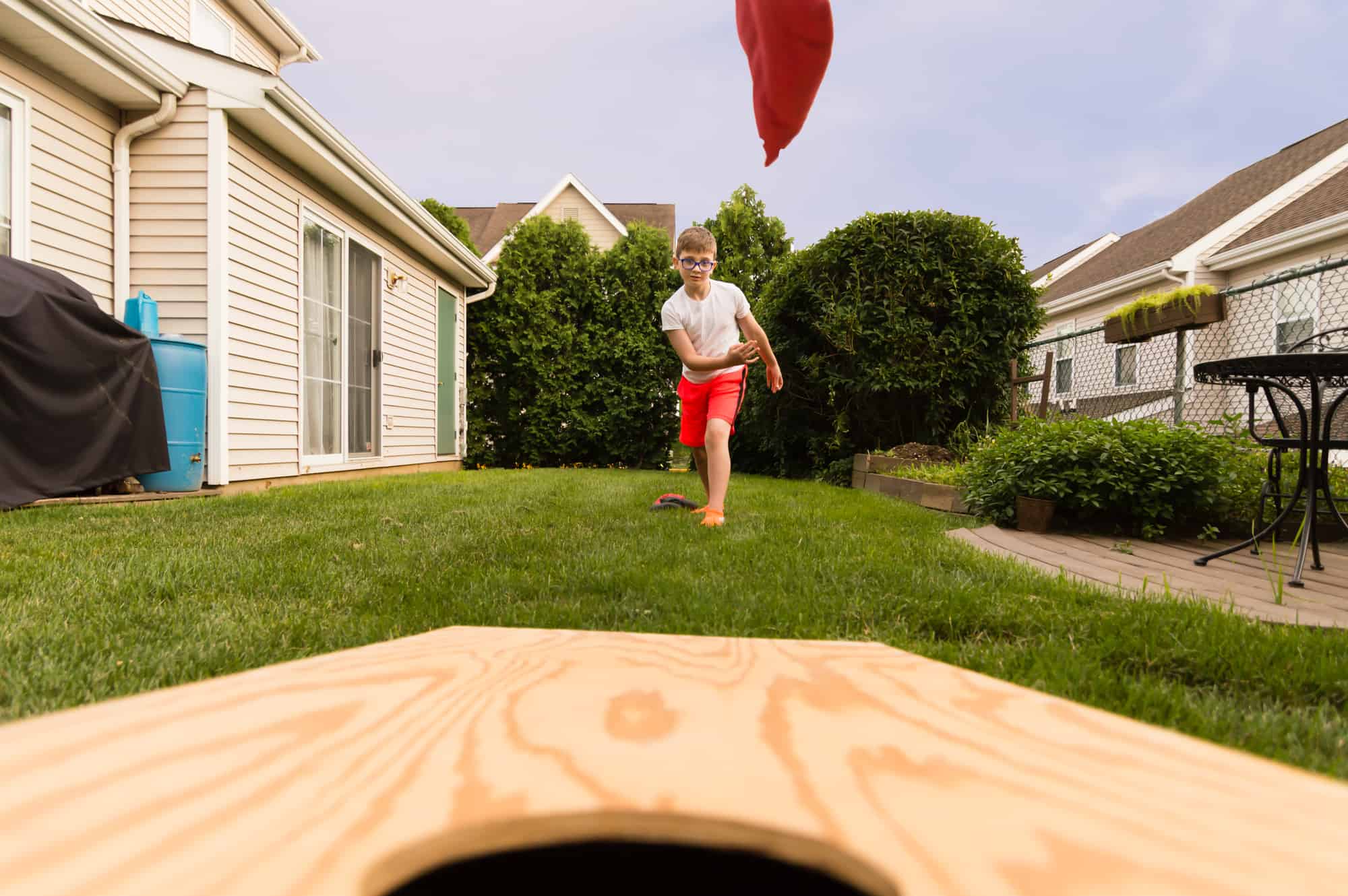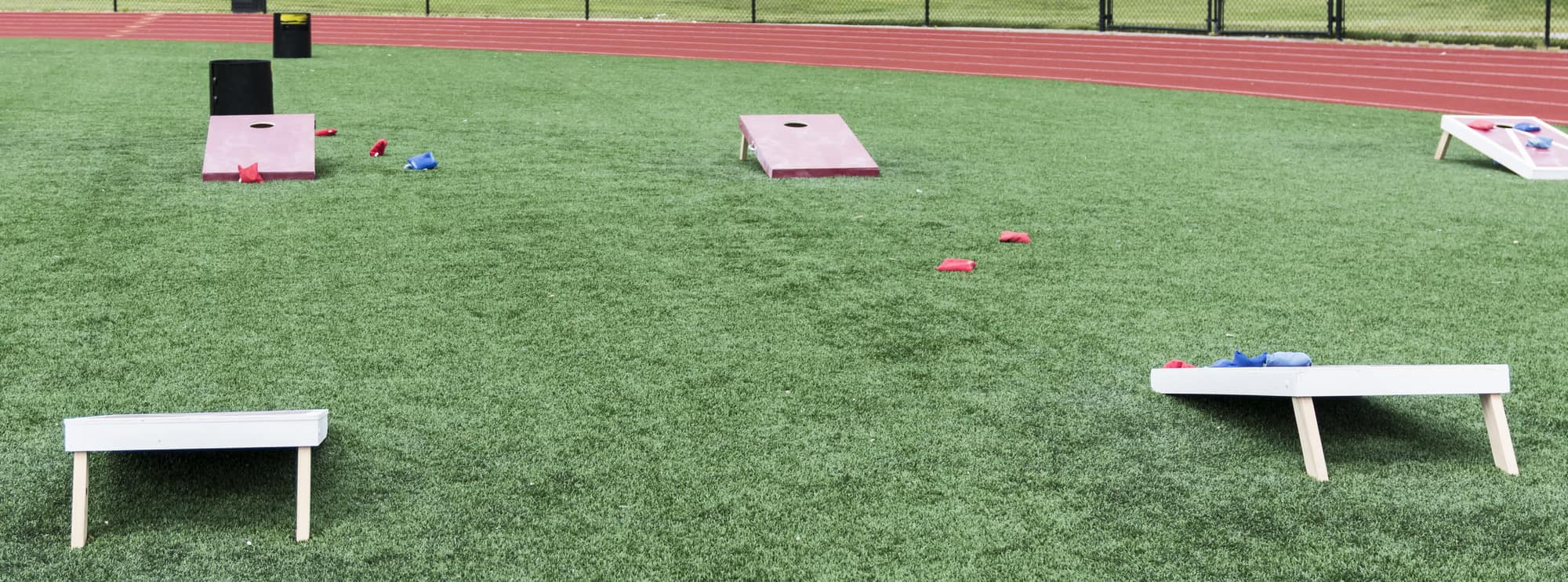Cornhole, also known as “bean bag toss,” is one of the most popular backyard games worldwide. It’s a staple of backyard barbecues, tailgate parties and picnics in the park. Whether you’re brand-new to the game or you’re a seasoned pro, read on for an in-depth guide about how to play cornhole.
Get Familiar with Cornhole Boards
Every cornhole setup involves at least two boards placed at either end of the court. Not all boards are created equal, though. The best boards are made from solid birch or solid poplar. Lightweight marine plywood, or okoume, boards are good, too. They should be surface treated both for long-term durability and smoothness.
The American Cornhole Association has set out guidelines for ideal board sizes. A regulation board should measure 4 feet by 2 feet and weigh up to 40 pounds. Most casual players use a tailgate-sized board measuring 3 feet by 2 feet. Even smaller travel size boards are available—they’re perfect for picnics or fun afternoons at the beach.

Choose Your Cornhole Bags
Once you’ve selected the right cornhole board, it’s time to choose your bags. Picking the right bags is more challenging than you think, since you need to find a bag that performs well with your throwing style.
There are tons of cornhole bags on the market in a variety of styles and designs. In truth, cornhole bags are much more than simple bean bags. How can you tell which bag is right for you?
If you’re following American Cornhole Association regulations, you need to choose a bag that’s 6 by 6 inches and weighs in the range of 15.5 – 16 ounces. Bags should have a .25-inch stitched seam on all side. According to regulation standards, bags should only be filled with resin pellets, but there are plenty of other filling options, including feed corn.
One of the most important considerations to keep in mind as you’re choosing a bag is material. Most double-sided bags feature a premium duck cloth on one side with suede on the other, giving you the option of throwing with the “slick” (duck cloth) side, or the “stick” (suede) side down. There’s an unlimited number of choices for slide materials, but if you’re looking for the best weather resistance, synthetic materials are your best bet.
Overall, the right cornhole bag is the one that feels right in your hand. It should match your throwing style and perform exactly as you want it to. It’s often best to not limit yourself to just one type of bag. Keep a variety of bags in your arsenal so you can adapt your game to weather conditions, board conditions and any other conditions that arise as you’re playing.
Setting Up and Learning How to Play Cornhole
Cornhole is played on a level, flat surface. A standard cornhole court should measure 8 to 10 feet wide and at least 40 to 45 feet long. Set up boards with 27 feet between them, with the area between them serving as the foul line. Angle the boards so that the front end is between 3 and 4 inches from the ground, and the highest point at the back is at least 12 inches from the ground. Pitcher’s boxes are 4 feet long and are parallel with and covering the entire length of the cornhole board.
Now that you’ve set up your boards the right way, it’s time to play a cornhole game! While you don’t need to stick to every rule if you’re just playing for fun, here are some guidelines for playing:
- Singles matches: In singles play, two competitors go head-to-head. Each player will stay in their designated lane during play, starting at their headboards and taking turns tossing their four bags until all bags have played. Players will then walk to the end of their lanes, take score and pitch to the opposite board for the next round. The first player to hit 21 points wins!
- Doubles matches: Doubles matches are played in teams of two. In the first round, each team alternate tossing bags until each has been pitched and scored. In the second round, players at the foot board take their turns, alternating throwing until all bags have been tossed. The winning team’s score is 21—when one team hits it, the inning is over!
Keeping Score in Cornhole
According to cornhole rules, scoring follows a “cancellation” method. Cancellation scoring involves canceling out the points of the opponent by scoring points, which means only one player or team can score in each inning. Scoring regulations are as follows:
- Bag in-the-count (Woody): Each bag that comes to rest anywhere on top of the board is worth one point.
- Bag in-the-hole (Cornhole): Each bag that’s either thrown through the hole or is knocked through it is worth three points.
The typical cornhole match is played in two rounds, or innings. Usually, teams play to 21 points, and the first player or team to hit that number in an inning wins. The first player or team to win two innings wins the match.

Cornhole Faults (and How to Avoid Them)
If you’re following cornhole rules, any cornhole bag that’s not a “woody” or a “cornhole” is considered a foul bag. Foul bags can meet any of the following criteria:
- Any bag tossed without at least one foot inside the pitcher’s box when the bag is released
- Any bag tossed when a player starts or steps completely outside the designated pitcher’s box before the bag is released
- Any bag not tossed within a 20-second time limit
- Any bag pitched from a different pitcher’s box than the first bag
- Any bag that contacts the ground before landing on the board
- Any bag that hits an obstruction before landing on the board
- Any bag removed from the board before scoring has been agreed upon
While fouls can’t be avoided completely, improving your throwing strategy and maintaining focus every time it’s your turn to toss can help you reduce your chance for fouls. Make every throw a score by following the strategies detailed below.
Strategies for Tossing Your Cornhole Bag
There are several ways to optimize your tossing technique to score points every time it’s your turn to play. Keep these helpful tips in mind the next time you’re tossing:
- Optimize your stance. First and foremost, you need to find a comfortable stance to throw cornhole bags the right way. While there’s no one technique that works for everyone, there are a few simple throwing stances you can try. One is to stand still with both feet slightly apart, using the arm as the only driving force for the toss, helping throwers maintain a fluid movement. Alternatively, you can take one step forward with the opposite foot of your throwing arm to gain momentum to throw the bag further.
- Adjust your aim. Many players new to cornhole don’t know where to aim. It’s a mistake to simply aim right at the hole—it’s easy to miss if you do this. Instead, focus on the middle of the board, so that even if your bag doesn’t go in the hole, you’ll still land on the board and be in position to obstruct your opponent’s throw.
- Add a spin. Most inexperienced cornhole players use an underhand tossing technique. This usually only results in the bag landing awkwardly on the board or bouncing of it. Improve your accuracy by giving the bag a Frisbee-style throw. Use a flat, spinning toss to get the bag where it needs to go. Using this technique, even bounces will be more accurate and direct the bag towards the cornhole.
Get Ready to Toss Bags at Your Opponent’s Cornhole Board!
Ready to head outside and enjoy a competitive game of cornhole with your friends? Make sure you have the gear you need—a quality board and bags that match your throwing style—and follow the rules detailed above for an exciting match. All that’s left to do is gather your crew and get throwing!
